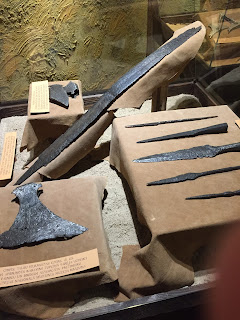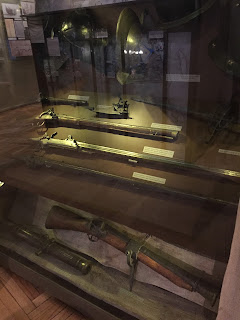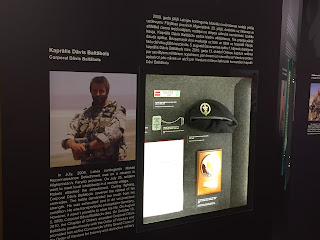195. Regional Travel #4.2 - Latvian War Museum
The Latvian War Museum is located in the center of Riga, in one of the most historic buildings in the city. Part of the museum is housed in the Powder Tower (so named because it was used to store gunpowder in the 1600s), one of the only surviving towers from the city's original medieval fortifications. The Powder Tower is first mentioned in documents in 1330, under
the name "Sandtower". In 1891, the city leased the half-ruined fortress
to a German student fraternity (Rubonia), which renovated the building and then gave it back to the city in 1919 for use as the War
Museum. In the 1950s through the 1980s, the museum was redesigned to present Latvian history from the Soviet view, but the War Museum was restored to its original Latvian perspective in 1990. Cannonballs are still visible in the tower's three-meter-thick walls, dating back to the Second Northern War in the 1650s.
The museum covers the entire history of warfare in Latvia, with exhibits focusing on the 9th-18th centuries, 17th-18th centuries, Latvian conscripts to the Russian imperial army during the 19th and early 20th century, the proclamation of the Latvian Republic and War of Independence from 1918-1920, WWI, WWII, and NATO & EU defense in the late 20th and early 21st centuries. The exhibits on the two separate Latvian wars of independence in the 20th century were fascinating, and I found all the other exhibits to be interesting, as well. The museum's collections include more than 25,000 weapons, uniforms, models, documents, and photos. I was surprised to find that this museum did not charge an admission fee, especially because this turned out to be one of my favorite museums in Riga.
Soldiers and warfare 9th-18th century:
Latvia and Latvian Soldiers 17th - 18th century:
Latvians in World War I:
Hand-crafted rings made by Latvian soldiers from re-cast aluminum artillery shell casings on "Death Island" during WWI:
Proclamation of Latvia Republic and War of Independence 1918-1920:
The Latvian conscripts during 19th century and early 20th century:
The Defense of Latvia Republic 1920-1940:
("The exhibition is devoted to the people who during the last stagnation years of the communist regime of the Soviet Union were the first who DARED to challenge the Soviet occupation regime in Latvia and start nonviolent resistance against it. To those who 30 years ago aroused and inspired the nation's Third Awakening.")
Latvia in World War II:
NATO & EU defense, late 20th / early 21st century:
The museum covers the entire history of warfare in Latvia, with exhibits focusing on the 9th-18th centuries, 17th-18th centuries, Latvian conscripts to the Russian imperial army during the 19th and early 20th century, the proclamation of the Latvian Republic and War of Independence from 1918-1920, WWI, WWII, and NATO & EU defense in the late 20th and early 21st centuries. The exhibits on the two separate Latvian wars of independence in the 20th century were fascinating, and I found all the other exhibits to be interesting, as well. The museum's collections include more than 25,000 weapons, uniforms, models, documents, and photos. I was surprised to find that this museum did not charge an admission fee, especially because this turned out to be one of my favorite museums in Riga.
Soldiers and warfare 9th-18th century:
Latvia and Latvian Soldiers 17th - 18th century:
Latvians in World War I:
Hand-crafted rings made by Latvian soldiers from re-cast aluminum artillery shell casings on "Death Island" during WWI:
Proclamation of Latvia Republic and War of Independence 1918-1920:
The Latvian conscripts during 19th century and early 20th century:
The Defense of Latvia Republic 1920-1940:
("The exhibition is devoted to the people who during the last stagnation years of the communist regime of the Soviet Union were the first who DARED to challenge the Soviet occupation regime in Latvia and start nonviolent resistance against it. To those who 30 years ago aroused and inspired the nation's Third Awakening.")
Latvia in World War II:
NATO & EU defense, late 20th / early 21st century:


























































Comments
Post a Comment